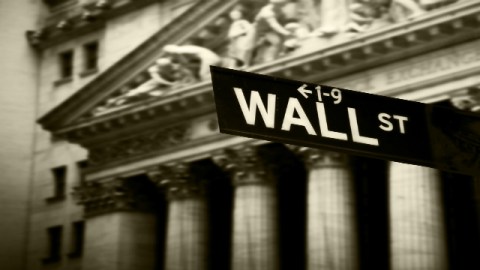The Future of Global Finance

In a piece about the Barclays traders who colluded to fix the London interbank offered rate (LIBOR), the Economist declared that the LIBOR scandal “could well be global finance’s ‘tobacco moment’….[It is imperative] to change the way finance is run—and the culture of banking.”
Perhaps because thefinancial industry’s operations are rapidly growing more sophisticated—Reuters recently ran a special report on the “algorithmic arms race”—I find that discussions of it sometimes confuse more than they explain. To get a sense of where it stands and where it’s headed, I zoomed in on Wall Street—perhaps the chief center and symbol of global finance—and spoke with:
POWER GAMES: What exactly is “Wall Street?” What are the main categories of firms (and other players) there, and how do you expect that makeup to change in the next decade?
ALLOWAY: Wall Street has, without a doubt, changed. It used to describe a fairly uniform group of businesses—like brokers and banks—clustered in the downtown area of lower Manhattan. These businesses were mostly focused on middle-man or financial-advisory roles. Now, more often than not, people use it to denote a disparate group of financial companies ranging from big investment banks to funds and clearing houses. In the future, the terminology will become even looser as financial power migrates from banks to non-banks. The middle-man function doesn’t work for banks anymore; there’s too much regulation, and the world has lost trust in them since the financial crisis.
EL-ERIAN:There are many ways to categorize the financial-services industry. The simplest is to differentiate between the “sell side” (“Wall Street”) and the “buy side” (consisting mainly of investment management firms such as PIMCO). Look for the sell side to shrink over the next few years in terms of its footing and activities….due to tighter regulation in the aftermath of the 2008 global financial crisis, as well as continued de-risking imposed by markets. The buy side will likely experience notable compositional changes as more firms are put up for sale by owners that no longer regard them as core (e.g., banks selling their asset management arms). Higher operational costs will also entail some degree of consolidation.
SHILLER:Wall Street has become a metaphor for the whole financial community. It’s loaded with emotion. Occupy Wall Street, which actually originated in Vancouver, put “Wall Street” in its name because that phrase is so powerful: it brings to mind the concentration of income and images of tough businessmen such as J. P. Morgan. The growing concentration of income is concerning, but it’s not the end of the world.
PG: Is it possible to regulate some of Wall Street’s higher-risk activities without preventing it from fully carrying out its core function of intermediating between borrowers and lenders?
ALLOWAY: You can regulate the big banks into oblivion, but that is exactly the point. When you clamp down on risk in one area, it doesn’t disappear. It simply mutates or migrates into another area of the financial system. As banks are squeezed by new rules, other players that are able to achieve the same result at less cost and hassle will step in. We’ve already seen insurers and companies start lending to banks, for instance. We’ve seen peer-to-peer lending that cuts out the banks altogether. We’ve seen BlackRock, an asset manager, seek to start its own bond–trading platform.
EL-ERIAN:At one end we have what is known as “narrow banking,” where institutions that benefit from government guarantees (e.g., deposit insurance and access to central bank financing windows) are limited essentially to just raising customer deposits and making loans. At the other end we have the relatively unfettered model that prevailed until recently in both the U.S. and Britain. Here, banks are allowed to engage in a much wider range of risky and complex activities, thus exposing taxpayers to significant contingent liabilities. Over the next few years, the pendulum will continue to swing towards narrow banking, though it will not reach the extreme. This will have some impact on credit available to the broader economy. Think of it as the tradeoff that society is willing to make to secure greater financial stability and soundness. And it is an understandable one, given that the inherent unfairness and unacceptability of the prior regime enabled the privatization of massive gains followed by the socialization of massive losses.
SHILLER: Imagine that you’re driving late at night in suboptimal conditions, and visibility is low. Even though you think you should slow down, you end up not slowing down because you don’t want to hold up traffic and have other drivers get upset at you. I think of the pre-crisis financial boom in this way. A key difference, though, is that highway experts can assess pretty readily if driving conditions are unsafe. They can put up flashing lights that tell people to slow down. It’s harder to do so with financial markets, where problems accumulate over decades. The Office of Financial Research is trying to identify the precursors to financial crises, but it won’t be able to find answers quickly. The economy is like an airplane: when it crashes, it takes a lot of work to figure out what caused the crash.
PG: Will increasingly complex trading models allow investors to quantify risk more accurately, or is it futile to attempt to quantify risk in the first place?
ALLOWAY: Technology is the future—not just on Wall Street, but everywhere. Banks need it to cut costs, and investors will buy into it because they think it gives them an edge. But it needs to be used with caution. One of the things that helped contribute to the financial crisis (and this never gets as much attention as it deserves) was the software that went into analyzing mortgage-backed securities and other packaged debt. Investors loved this because you could run a program, and it would spit back a bunch of charts and data points that made you think you understood the risks. Of course, if you didn’t stop to think about the assumptions underpinning that output, you had a big problem on your hands come 2008.
EL-ERIAN:Well-designed models contain important insights. They can also serve to impose greater analytical discipline and coherence. But they cannot be fully accurate. And they are especially challenged in a world full of structural change.
PG: Are global financial crises of ever-increasing severity a given?
ALLOWAY: Financial history is littered with booms and busts, so I hesitate to say they arepreventable. However, my gut feeling is that with the right controls on things like financial-institution size and leverage, these booms and busts could be minimized. But getting the controls right is a difficult thing. Risk tends to flow faster than regulators can regulate. They are constantly playing catch-up.
EL-ERIAN: This is certainly something that needs to be taken into account. The world—and the advanced economies in particular—is in the midst of a challenging transition as it de-levers after the abuses of what we at PIMCO have called the “great age of leverage, debt creation, and credit entitlement”—great…in the sense of a historic phase that went too far. This inherently tricky phase is made even more complicated and uncertain by two interrelated realities: extreme political polarization, and a policy approach that is way too tactical and not sufficiently strategic.
SHILLER: The risk that swaps and derivatives pose is real, but it shouldn’t be overstated. There’s no evidence that financial crises since the Great Depression have become more severe. In fact, I worry more about climate change. Or what if there’s a pandemic? The future is much riskier than we imagine. Who in 1900 would’ve imagined World War I, then the Great Depression, and then World War II?
Follow Ali Wyne on Twitter and Facebook.
Photo Credit: Stuart Monk/Shutterstock.com





